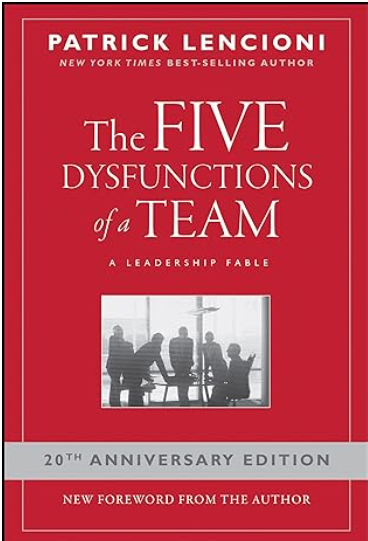The Five Dysfunctions of a Team is a popular book that is recommended and studied by leaders, managers, and team members in diverse industries. Written by renowned author Patrick Lencioni, this book presents the five common dysfunctions that can hinder a team’s success.

Fable-style storytelling
A unique feature of The Five Dysfunctions of a Team is its use of fable-style storytelling to convey its message. This renders it a captivating read for audiences who might not be inclined towards conventional leadership and management literature.
The story tracks Kathryn Petersen, CEO of DecisionTech, tackling the task of uniting a dysfunctional team. Readers grasp team dysfunctions and their impact on dynamics through her experiences and interactions with team members.
The Five Dysfunctions
As mentioned earlier, The Five Dysfunctions of a Team presents five main dysfunctions that can hinder a team’s success. These include:
- Absence of Trust
- Fear of Conflict
- Lack of Commitment
- Avoidance of Accountability
- Inattention to Results
Each dysfunction is thoroughly explained, covering the origins and impacts on a team. The story also provides suggestions and strategies for overcoming these dysfunctions.
Importance of Trust
Trust is key for a successful team, highlighted as the primary dysfunction in The Five Dysfunctions of a Team. Without trust, team members can’t be open or vulnerable, hindering healthy conflict, commitment, accountability, and results.
Kathryn Petersen learns that building trust requires vulnerability from all team members, including herself. This is a powerful lesson for leaders who may struggle with being vulnerable and open with their teams.
Overcoming Dysfunctions
Each dysfunction presents distinctive challenges but is interlinked, requiring trust-building within the team. This goal is attainable through open communication, promoting constructive conflict, and cultivating a culture of accountability.
The story also emphasizes the importance of leadership in overcoming these dysfunctions. A strong leader, Kathryn Petersen, drives her team to success by setting clear expectations, ensuring accountability, and fostering team unity.
Application in Real Life
The Five Dysfunctions of a Team offers valuable insights that are directly applicable to real-world scenarios. For team leaders or members, this book provides practical strategies to enhance team dynamics and achieve success.
Key takeaways: Trust building, healthy conflict promotion, and leadership’s vital role in team cohesion. By applying these concepts, teams can overcome dysfunctions and work towards achieving their goals.
Conclusion
In conclusion, The Five Dysfunctions of a Team highlights common team challenges and provides strategies to overcome them. Building trust, encouraging healthy conflict, and strong leadership are key for teams to be effective and achieve better results. Individuals can apply these principles in their interactions to strengthen teams. Let’s focus on trust, open communication, and accountability for collective success. The book’s timeless lessons apply to any team, a must-read for improving teamwork skills.







